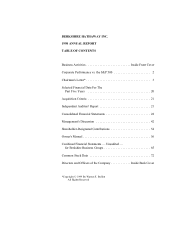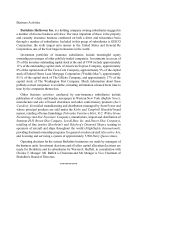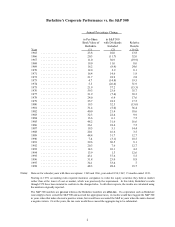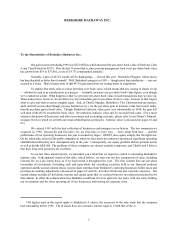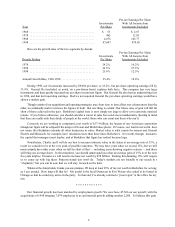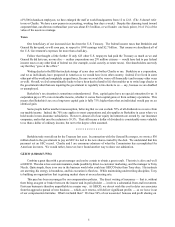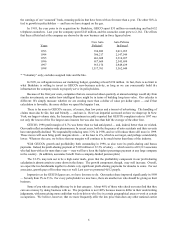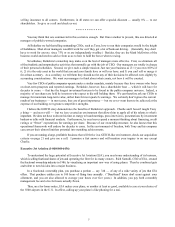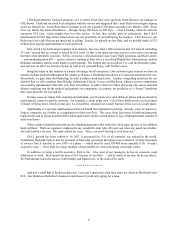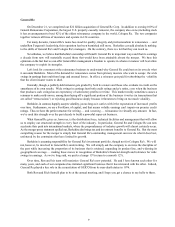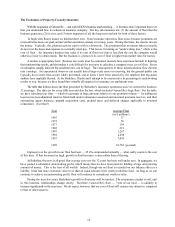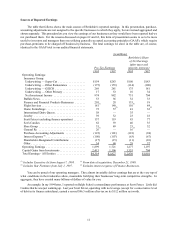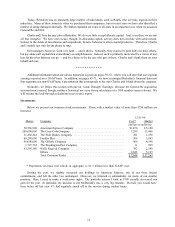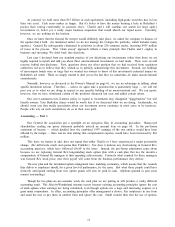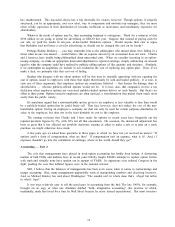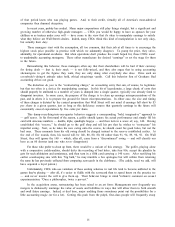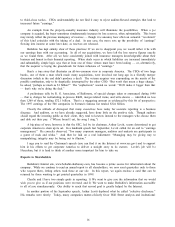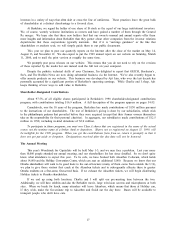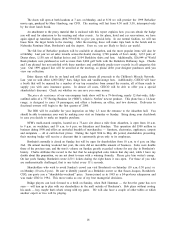Berkshire Hathaway 1998 Annual Report Download - page 9
Download and view the complete annual report
Please find page 9 of the 1998 Berkshire Hathaway annual report below. You can navigate through the pages in the report by either clicking on the pages listed below, or by using the keyword search tool below to find specific information within the annual report.8
I first heard about the NetJets® program, as it is called, about four years ago from Frank Rooney, our manager at
H.H. Brown. Frank had used and been delighted with the service and suggested that I meet Rich to investigate signing
up for my family’s use. It took Rich about 15 minutes to sell me a quarter (200 hours annually) of a Hawker 1000. Since
then, my family has learned firsthand — through flying 900 hours on 300 trips — what a friendly, efficient, and safe
operation EJA runs. Quite simply, they love this service. In fact, they quickly grew so enthusiastic that I did a
testimonial ad for EJA long before I knew there was any possibility of our purchasing the business. I did, however, ask
Rich to give me a call if he ever got interested in selling. Luckily, he phoned me last May, and we quickly made a $725
million deal, paying equal amounts of cash and stock.
EJA, which is by far the largest operator in its industry, has more than 1,000 customers and 163 aircraft (including
23 “core” aircraft that are owned or leased by EJA itself, so that it can make sure that service is first-class even during
the times when demand is heaviest). Safety, of course, is the paramount issue in any flight operation, and Rich’s pilots
— now numbering about 650 — receive extensive training at least twice a year from FlightSafety International, another
Berkshire subsidiary and the world leader in pilot training. The bottom line on our pilots: I’ve sold the Berkshire plane
and will now do all of my business flying, as well as my personal flying, with NetJets’ crews.
Being the leader in this industry is a major advantage for all concerned. Our customers gain because we have an
armada of planes positioned throughout the country at all times, a blanketing that allows us to provide unmatched service.
Meanwhile, we gain from the blanketing because it reduces dead-head costs. Another compelling attraction for our
clients is that we offer products from Boeing, Gulfstream, Falcon, Cessna, and Raytheon, whereas our two competitors
are owned by manufacturers that offer only their own planes. In effect, NetJets is like a physician who can recommend
whatever medicine best fits the needs of each patient; our competitors, in contrast, are producers of a “house” brand that
they must prescribe for one and all.
In many cases our clients, both corporate and individual, own fractions of several different planes and can therefore
match specific planes to specific missions. For example, a client might own /16th of three different jets (each giving it
1
50 hours of flying time), which in total give it a virtual fleet, obtained for a small fraction of the cost of a single plane.
Significantly, it is not only small businesses that can benefit from fractional ownership. Already, some of America’s
largest companies use NetJets as a supplement to their own fleet. This saves them big money in both meeting peak
requirements and in flying missions that would require their wholly-owned planes to log a disproportionate amount of
dead-head hours.
When a plane is slated for personal use, the clinching argument is that either the client signs up now or his children
likely will later. That’s an equation I explained to my wonderful Aunt Alice 40 years ago when she asked me whether
she could afford a fur coat. My reply settled the issue: “Alice, you aren’t buying it; your heirs are.”
EJA’s growth has been explosive: In 1997, it accounted for 31% of all corporate jets ordered in the world.
Nonetheless, Rich and I believe that the potential of fractional ownership has barely been scratched. If many thousands
of owners find it sensible to own 100% of a plane — which must be used 350-400 hours annually if it’s to mak e
economic sense — there must be a large multiple of that number for whom fractional ownership works.
In addition to being a terrific executive, Rich is fun. Like most of our managers, he has no economic need
whatsoever to work. Rich spends his time at EJA because it’s his baby — and he wants to see how far he can take it.
We both already know the answer, both literally and figuratively: to the ends of the earth.
* * * * * * * * * * * *
And now a small hint to Berkshire directors: Last year I spent more than nine times my salary at Borsheim’s and
EJA. Just think how Berkshire’s business would boom if you’d only spring for a raise.

